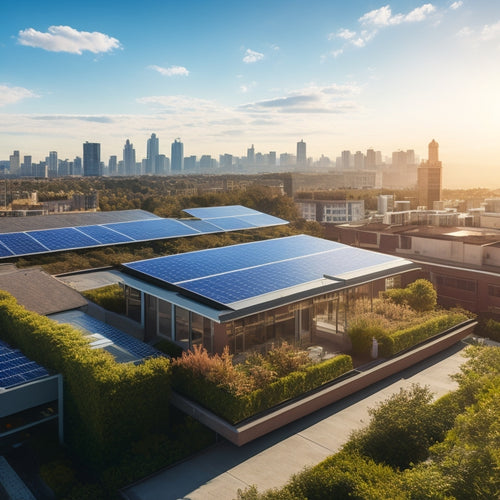
Roof and Solar Panel Cleaning Tips for Homeowners
Share
You'll want to prioritize regular roof and solar panel cleaning to prevent damage, maintain your home's aesthetic appeal, and optimize energy production. Neglecting cleaning can lead to premature aging, reduced roof longevity, and decreased energy output. For safe and effective cleaning, use eco-friendly solutions, soft-bristled brushes, and gentle rinsing techniques. Invest in the right tools, like extension poles and water-fed hoses, and establish a maintenance schedule to stay on track. By doing so, you'll be well on your way to maximizing your roof's and solar panels' performance; now, take the next step to access more expert information and customized tips for your specific needs.
Key Takeaways
- Regular roof cleaning is essential to maintain roof integrity, performance, and aesthetic appeal, and to prevent premature aging and water damage.
- For solar panels, use eco-friendly solutions, soft-bristled brushes, and gentle rinsing to maximize energy production and panel efficiency.
- Prioritize ladder safety when accessing the roof, ensuring secure positioning, three points of contact, and harness usage on steep roofs.
- Use gentle cleaning tools and equipment, such as soft-bristle brushes, mild soap, and water-fed poles, to remove debris and grime without causing damage.
- Establish a routine maintenance schedule, including quarterly inspections and seasonal tasks, to optimize roof and solar panel performance and longevity.
Understanding Roof Cleaning Importance
Across your roof, dirt, debris, and grime silently accumulate, compromising its integrity and performance over time.
As a homeowner, you mightn't notice the gradual decline, but the consequences can be costly. Neglecting regular roof cleaning can lead to premature aging, reducing roof longevity and increasing the risk of leaks, damage, and even collapse.
Additionally, a dirty roof can greatly diminish your home's aesthetic appeal, affecting its curb appeal and resale value.
Regular roof cleaning is essential to maintaining its performance and extending its lifespan. It allows your roof to function as intended, efficiently reflecting sunlight, and keeping your home cool.
A clean roof also guarantees that water flows freely, reducing the risk of ice dams and water damage.
By investing in regular roof cleaning, you're protecting your investment and preserving your home's integrity.
Don't wait until it's too late; take proactive measures to safeguard your roof's health and longevity.
Solar Panel Cleaning Methods Explained
Since your roof is now sparkling clean, it's time to turn your attention to your solar panels. Cleaning them regularly is vital to maintain their efficiency and maximize energy production.
You have two primary options for cleaning your solar panels: manual cleaning and professional services.
Manual cleaning involves using eco-friendly solutions and soft-bristled brushes to gently remove dirt and debris. You can also use a hose with a spray nozzle to rinse the panels. However, be cautious not to use high-pressure washes or harsh chemicals, as they can damage the panels.
If you're not comfortable with heights or don't have the time, consider hiring professional services. They'll use specialized equipment and techniques to guarantee a thorough cleaning.
Many companies also offer maintenance packages that include regular cleanings and inspections to ensure your solar panels operate at peak performance.
Safety Precautions for Roof Access
Before you start cleaning your roof or solar panels, make certain you take necessary safety precautions to avoid accidents. Roof access can be hazardous, especially when working at heights. You must prioritize ladder safety to prevent falls and injuries.
Always inspect your ladder for damage or wear before use, and verify it's securely positioned on a level surface. Maintain three points of contact with the ladder, whether it's two hands and one foot or two feet and one hand.
Consider investing in a ladder stabilizer or leveler to enhance stability. Additionally, wear non-slip shoes with good traction to prevent slipping.
When working on steep or high roofs, harness usage is vital. A properly fitted harness can be the difference between life and death. Confirm your harness is securely attached to a stable anchor point, and always maintain a safe distance from the roof's edge.
Never lean over the side of the roof or ladder to reach for something – instead, move the ladder to a position where you can safely access the area.
Cleaning Tools and Equipment Needed
With safety precautions in place, you can now focus on gathering the necessary tools and equipment to effectively clean your roof and solar panels.
Having the right tools will guarantee a thorough cleaning job and help you avoid damaging your roof or solar panels.
You'll need the following essential equipment:
- Soft-bristle brushes or soft cloth to gently remove debris from solar panels and roof surfaces.
- Cleaning solutions, such as mild soap and water or specialized solar panel cleaning solutions, to effectively remove dirt and grime.
- Extension poles or ladders to reach high areas, guaranteeing safe access to your roof and solar panels.
- Water-fed poles or hoses with spray nozzles to rinse off soap and debris, preventing streaks and water spots.
When selecting equipment types, prioritize durability, quality, and compatibility with your roof and solar panel materials.
Avoid using abrasive materials or harsh chemicals, as they can damage your roof or solar panels.
Maintenance Schedules for Optimal Performance
Get into a routine of regular maintenance to guarantee your roof and solar panels perform at their best. A well-planned maintenance schedule is essential for performance optimization and extending the lifespan of your roof and solar panels.
Divide your maintenance tasks into seasonal checklists to verify you're addressing specific needs during different times of the year. Schedule quarterly inspections to identify potential issues before they become major problems. During these inspections, check for debris buildup, inspect flashing and seals, and verify that all components are securely fastened.
Perform seasonal maintenance tasks, such as cleaning gutters and downspouts in the fall, and inspecting roof vents and skylights in the spring. For your solar panels, clean them every 6-12 months, or as needed, to guarantee maximum energy output.
Frequently Asked Questions
Can I Use a Pressure Washer to Clean My Roof and Solar Panels?
You might think a pressure washer is a quick fix, but it's actually a recipe for damage; instead, you'll want to take safety precautions and employ gentle cleaning techniques to guarantee a thorough, damage-free cleaning of your roof and solar panels.
How Often Should I Inspect My Roof and Solar Panels for Debris?
You should inspect your roof and solar panels quarterly for debris, ensuring ideal roof maintenance and solar care; this frequency helps prevent damage, maintains energy efficiency, and prolongs their lifespan, saving you time and money in the long run.
Are There Any Eco-Friendly Roof and Solar Panel Cleaning Solutions Available?
You're about to uncover a breakthrough: eco-friendly roof and solar panel cleaning solutions that utilize natural ingredients and biodegradable cleaners, ensuring a guilt-free sparkle while protecting the planet - and they're surprisingly effective!
Can I Clean My Roof and Solar Panels During Winter or Rainy Weather?
You shouldn't attempt winter cleaning, as icy roofs and solar panels can be hazardous; instead, you'll need to take safety precautions, such as using specialized equipment and waiting for clear weather to guarantee a secure and effective cleaning process.
Do I Need to Clean the Underside of My Solar Panels as Well?
When performing solar panel maintenance, you'll need to take into account cleaning the underside as well, as debris accumulation can reduce energy output; aim to clean both sides during your regular cleaning frequency to guarantee peak performance.
Related Posts
-

Charging Points in Rural Areas: 5 Key Insights
When driving through rural areas, you'll face a shortage of charging points, making EV ownership stressful and inconv...
-

Why Certification Matters for Residential Panels
You're looking to understand why certification matters for residential panels. Basically, third-party certification g...
-

What Is the Cost to Put in Solar Panels
You're likely considering solar panels for your home, and the most significant factor in your decision is the upfront...


